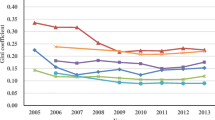Abstract
This study aimed to discover the associations between the number of computed tomography (CT) scanners and the population, as well as number of medical resources to identify regional disparities in Japan. The number of CT scanners was tabulated for each detector row of CT scanners for hospitals and clinics in each prefecture. The number of CT scanners, patients, medical doctors, radiological technologists, facilities, and beds per 100,000 population was compared. Additionally, the number of hospitals with ≥ 200 beds and multidetector-row CT scanners with ≥ 64 rows were tabulated, and their ratios were calculated. Medical institutions in Japan have installed 14,595 scanners. CT scanners per 100,000 population were the highest in Kochi Prefecture, although the number of CT scanners in hospitals was the highest in Tokyo Prefecture. Multivariate analysis revealed the number of radiological technologists (β coefficient: 0.49; P = 0.03), facilities (β coefficient: 0.12; P < 0.01) and beds (β coefficient: 0.46; P < 0.01) as independent factors for the number of CT scanners. Prefectures with a high proportion of hospitals with ≥ 200 beds also had a relatively high proportion of CT scanners with ≥ 64 rows (P < 0.01). Our survey revealed an association between regional disparities in the number of CT scanners in Japan, the population, and number of medical resources. A positive correlation was found between hospital size and number of CT scanners with ≥ 64 rows.







Similar content being viewed by others
References
Niki R. The wide distribution of CT scanners in Japan. Soc Sci Med. 1985;21(10):1131–7.
OECD. Computed tomography (CT) scanners (indicator). doi: https://doi.org/10.1787/bedece12-en Accessed on 01 Nov 2022.
OECD. Computed tomography (CT) exams (indicator). doi: https://doi.org/10.1787/3c994537-en (Accessed on 01 November 2022).
Aberle DR, Berg CD, Black WC, Church TR, Fagerstrom RM, Galen B, et al. The national lung screening trial: overview and study design. Radiology. 2011;258(1):243–53.
Takami M, Nohda K, Sakanaka J, Nakamura M, Yoshida M. Usefulness of full spine computed tomography in cases of high-energy trauma: a prospective study. Eur J Orthop Surg Traumatol. 2014;24(Suppl 1):S167–71.
Takada K, Toyoda H, Tada T, Ito T, Hasegawa R, Gotoh T, et al. Accurate and rapid identification of feeding arteries with multidetector-row angiography-assisted computed tomography for transarterial chemoembolization for hepatocellular carcinoma. J Gastroenterol. 2015;50(12):1190–6.
Naruto N, Itoh T, Noguchi K. Dual energy computed tomography for the head. Jpn J Radiol. 2018;36(2):69–80.
Lell MM, Wildberger JE, Alkadhi H, Damilakis J, Kachelriess M. Evolution in computed tomography: the battle for speed and dose. Investig Radiol. 2015;50(9):629–44.
Abdelrahman KM, Chen MY, Dey AK, Virmani R, Finn AV, Khamis RY, et al. Coronary computed tomography angiography from clinical uses to emerging technologies: JACC state-of-the-art review. J Am Coll Cardiol. 2020;76(10):1226–43.
Lell MM, Kachelrieß M. Recent and upcoming technological developments in computed tomography: high speed, low dose, deep learning, multienergy. Invest Radiol. 2020;55(1):8–19.
Hsieh J, Flohr T. Computed tomography recent history and future perspectives. J Med Imaging (Bellingham). 2021;8(5): 052109.
Ministry of Health Labor and Welfare; Calculation of medical fees [Available from: https://www.mhlw.go.jp/web/t_doc?dataId=84aa9729&dataType=0.
Welfare MoHLa. Survey of Medical Facilities (T74) [Available from: https://www.e-stat.go.jp/stat-search/files?page=1&layout=datalist&toukei=00450021&bunya_l=15&tstat=000001030908&cycle=7&tclass1=000001165107&tclass2=000001165167&tclass3=000001165169&stat_infid=000032191932&tclass4val=0.
Welfare MoHLa. Survey of Medical Facilities (T110) [Available from: https://www.e-stat.go.jp/stat-search/files?page=1&layout=datalist&toukei=00450021&bunya_l=15&tstat=000001030908&cycle=7&tclass1=000001165107&tclass2=000001165167&tclass3=000001165169&tclass4val=0.
Welfare MoHLa. Population estimation [Available from: https://www.e-stat.go.jp/dbview?sid=0003448418.
Welfare MoHLa. Survey of Medical Facilities (T11) [Available from: https://www.e-stat.go.jp/stat-search/files?page=1&layout=datalist&toukei=00450021&bunya_l=15&tstat=000001030908&cycle=7&tclass1=000001169866&tclass2=000001169868&stat_infid=000032235653&tclass3val=0.
Welfare MoHLa. Survey of Medical Facilities (T83) [Available from: https://www.e-stat.go.jp/stat-search/files?page=1&layout=datalist&toukei=00450021&bunya_l=15&tstat=000001030908&cycle=7&tclass1=000001165107&tclass2=000001165167&tclass3=000001165169&tclass4val=0.
Ministry of Health Labor and Welfare; [Available from: https://www.mhlw.go.jp/web/t_doc?dataId=84aa9729&dataType=0.
Kanda Y. Investigation of the freely available easy-to-use software “EZR” for medical statistics. Bone Marrow Transplant. 2013;48(3):452–8.
YM. Background and issues of regional differences in the number of hospital beds. Japan Medical Association Research Institute; 2017.
Imai S, Akahane M, Imamura T. Computed tomography: return on investment and regional disparity factor Analysis. Front Public Health. 2019;6:380.
Radiation UNSCotEoA. UNSCEAR 2020/2021 Report. Volume I Annex C Sources, effects and Risks of Ionizing Radiation. 2021.
Japan MotEGo. Available from: https://www.env.go.jp/chemi/rhm/r3kisoshiryo/r3kiso-02-05-03.html#main.
Acknowledgements
Part of the content of this study was based on the survey results of the scientific research group of the Japanese Society of Radiological Technology (No. 0032894).
Funding
Part of this study was financially supported by a grant of JSPS KAKENHI Grant No. 22K15834.
Author information
Authors and Affiliations
Corresponding author
Ethics declarations
Ethical statement
This article did not contain any studies involving human participants.
Additional information
Publisher's Note
Springer Nature remains neutral with regard to jurisdictional claims in published maps and institutional affiliations.
Supplementary Information
Below is the link to the electronic supplementary material.
About this article
Cite this article
Urikura, A., Yoshida, T., Matsubara, K. et al. Number of computed tomography scanners and regional disparities based on population and medical resources in Japan. Radiol Phys Technol 16, 355–365 (2023). https://doi.org/10.1007/s12194-023-00725-2
Received:
Revised:
Accepted:
Published:
Issue Date:
DOI: https://doi.org/10.1007/s12194-023-00725-2




